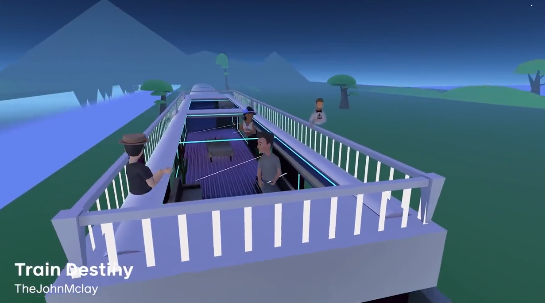SOCIAL
Meta Launches New Creator Funding Programs to Fuel Development of the Metaverse

Meta’s moving fast into the next stage of digital connection – or at least, it’s setting the stage for metaverse development, with two new creator funding options that are designed to better incentivize user contributions to its digital worlds.
The first is an expansion of its $10 million Horizon Worlds Creator Funding program, which it first launched in October last year.
Horizon Worlds is Meta’s VR sandbox, where creators can build their own immersive experiences. And now, they’ll have another means of monetizing those efforts.
As explained by Meta:
“We’re beginning to test a Horizon Worlds Creator Bonus program for participants in the US. These bonuses come in the form of goal-oriented monthly programs where the creators are paid out at the end of the month for their progress toward the goal.”
The idea, according to Meta CEO Mark Zuckerberg, is to ‘reward the people who are doing awesome work in Horizon’, though the bonuses will be focused on specific elements that Meta’s looking to build on within the VR environment. So if Meta sees that users are engaging with a certain element of its virtual experience, it can make that an incentive goal for others, or it can get creative with ‘the most interactive’ world or ‘the most creative uses of VR’ in any given month to better fuel advanced development.
By using its creator community, Meta stands a better chance of tapping into the key trends and options that will drive the most engagement, because the pool of creators is then exponentially larger than Meta’s own team.
That could help it advance its Horizon Worlds offerings faster, making VR a more engaging and immersive element.
The second element is likely the more interesting aspect – Meta’s also launching a pilot program that will enable some creators to sell virtual items and effects within their VR worlds.
“For example, someone could make and sell attachable accessories for a fashion world or offer paid access to a new part of a world.”
Digital items are the next big trend, with NFTs acting as a guiding light of sorts towards that next plain – though much of the NFT hype seems largely misguided, as there is a future in digital items, definitely, but whether those digital items will be avatars of monkey drawings, probably not.
NFT advocates will say that I’m missing the point, but I would argue that the reverse is true – absolutely, the development of VR worlds will see a new wave of digital goods that can be used in virtual environments, which will increasingly become a part of how we connect. That element of the trend is inarguable, but there are currently zero NFT projects that are ‘metaverse ready’, despite claims to the contrary, and I would argue that no one will be overly keen to visit galleries of JPEG collections within this new experience.
People will be looking to spend on items that provide utility, like in-world tools that enhance their experience, or cosmetics, like avatar clothing, that will help them customize their look. Some NFT projects are working towards this, by creating full-scale avatar versions of their characters, but again, I don’t see that becoming a key trend, based on what we’ve seen thus far in other, similar experiences.
For example, Fortnite is one template for the metaverse expansion, with players able to represent themselves via custom avatars and weapons that are aligned to their personal preferences. In fact, that’s already the key revenue element for the game, with Fortnite generating billions in sales via its in-game store, where people can purchase various enhancements.
And on Fortnite, despite a vast array of choices, the most popular skins likely point to where this trend is headed. Spiderman, Deadpool, John Wick. With players able to choose from almost any form of character, the most popular skins are, in the end, the ones that look the coolest, not the most unique, which suggests that most people are likely going to gravitate in that direction, while also looking to customize their own Facebook avatars to make characters that look more like themselves.
Basically, I don’t think that people are going to want to look like full-sized Pixel Punks or Bored Apes, which will limit the utility of the current popular NFT characters, even with their additional community benefits and other offerings considered.
But either way, digital items are clearly going to be a thing, and Meta’s new push will provide an immediate way for VR creators to offer enhanced experiences for in-world fees.
How will creators get paid in the metaverse? We’re testing new tools in Horizon Worlds for creators to sell items and earn money through bonus programs. https://t.co/hicJIFIkBa
Mark Zuckerberg discusses with creators what the metaverse economy might look like: pic.twitter.com/esRzaAqZam
— Meta Newsroom (@MetaNewsroom) April 11, 2022
It’s a smart move from Meta, building with collaboration in mind from the beginning, which, again, will greatly expand its creative potential, and enable new trends to organically evolve, helping to generate interest, and bring in new users.
Couple this with Meta’s evolving efforts to provide 3D scanning options for eCommerce brands, and you can see how its metaverse will soon be populated with a massive array of digital products, which could be made customizable (for a fee) along with different abilities, utilities, etc.
It’ll still take some time, but adoption of VR is rising, while more than 10,000 environments have already been created in Horizon Worlds to date.
As those experiences advance, that’ll drive more adoption, and while we may not all be spending the majority of our days in the metaverse by the end of 2022, you can see how it’s evolving, and will become a bigger consideration over time.
Meta says that purchasing items in Horizon Worlds will be available to adult users in the US and Canada to begin with.

















You must be logged in to post a comment Login